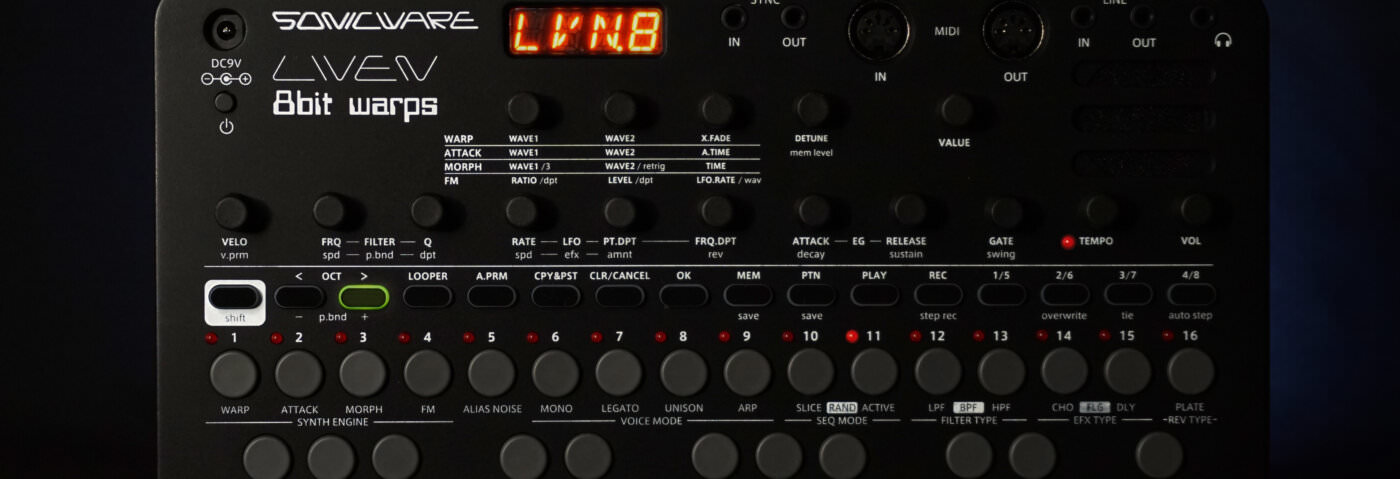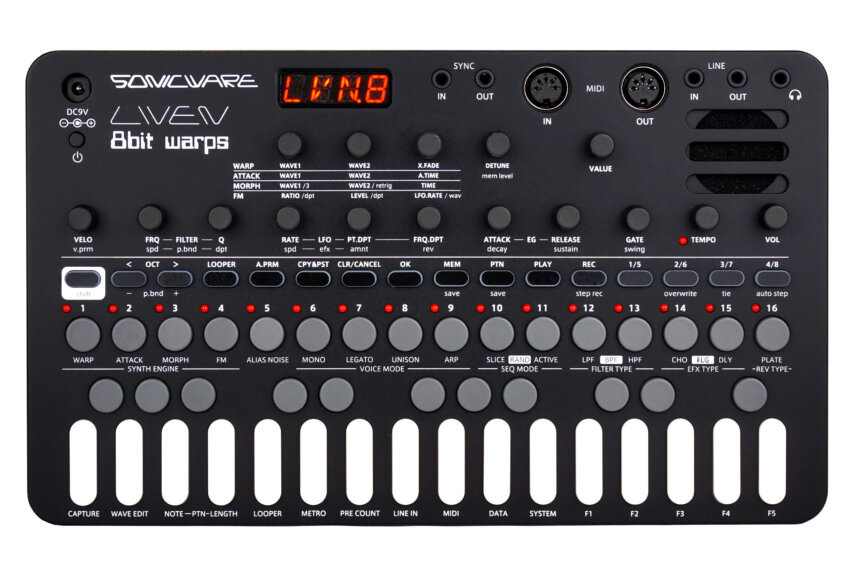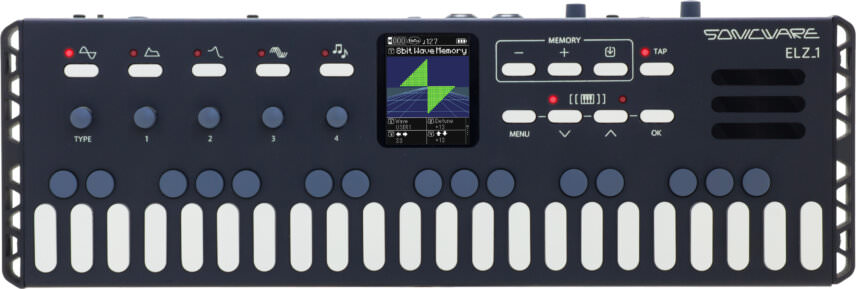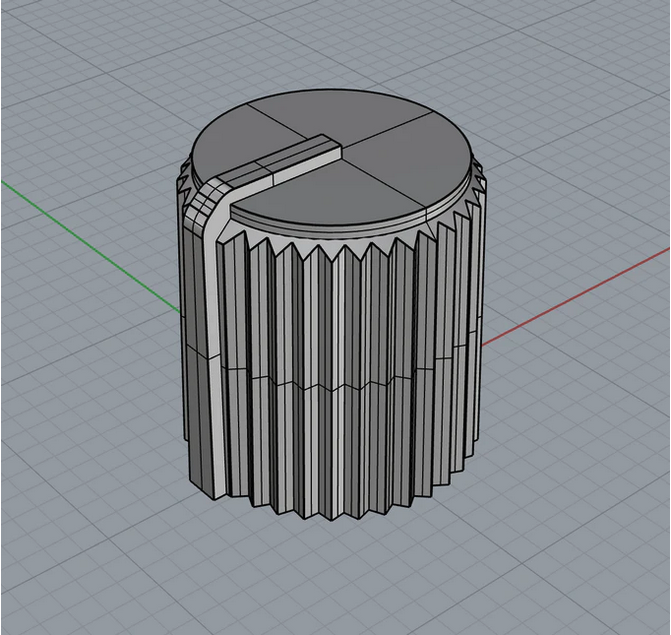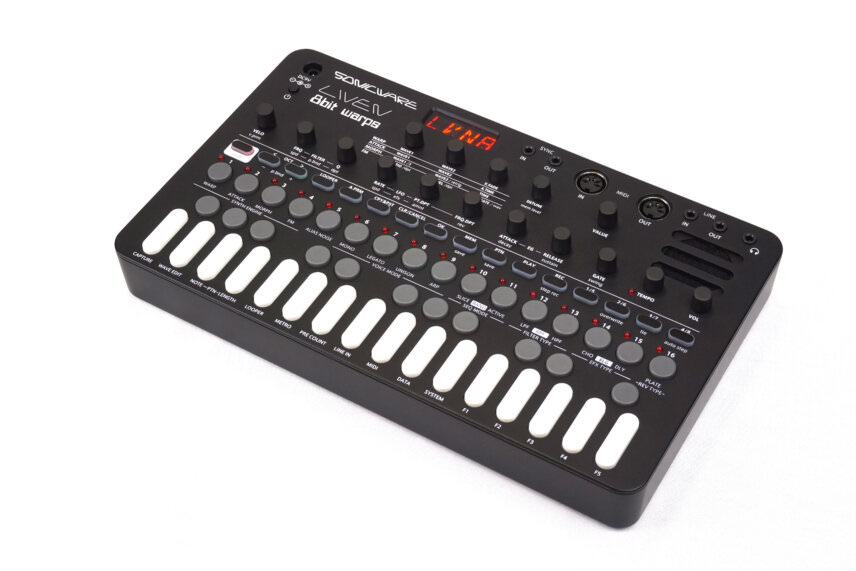Creating a new synthesizer is a long journey full of challenges, deadlines and pressures. We talked with Japanese boutique instrument company Sonicware about the process behind the making of their new synthesizer, Liven 8bit warps.
Your new synthesizer arrives, fully formed and ready to be played. It’s a modern marvel of engineering, science and—depending on your understanding of electronics—perhaps even magic. We adore them so much, even the act of unboxing has become a ritualised event. That a mass-produced product could inspire so much creativity, so much joy, is testament to the amount of work that must have gone into its creation.
What of the creation process? For most of us end-consumers, our relationship with these instruments begins when the box opens. Bar a few in-progress updates from social-media-savvy manufacturers, the actual day-to-day of synthesizer creation remains a mystery. What really does go into the making of a synthesizer from scratch?
We ourselves were curious about this process so we got in touch with Sonicware, a boutique synthesizer company based in Tokyo, Japan. We wanted to find out how their latest, the performance-based Liven 8 bit warps, came to be. Founder and CEO Dr Yu Endo granted us a behind-the-scenes look.
Liven It Up
Liven 8bit warps is, as the name suggests, an 8-bit digital synthesizer. It’s a spin-off of sorts from Sonicware’s previous ELZ_1 but aimed more at the performing musician. There are four 8-bit voice modes, including three borrowed from the ELZ_1 (Warp, Morph, and FM) and one new one, Attack, which lets you split a sound between two waveforms using an envelope. There are 128 waveforms to choose from and these are run through a multimode digital filter and a comprehensive effects section. As it’s performance-focused, there’s a 128-step pattern sequencer, four-track looper, parameter locks, and a dynamic sequencer mode with slice, random, and stutter effects. It also has a built-in speaker, a keyboard with 27 keys, and can run on batteries or a power adapter.
In our opinion, there haven’t really been any brand new instrument inventions used around the world since the birth of the synthesizer.
Dr Yu Endo
A Brand New Instrument
Before we go any further with the Liven though, we should back up and talk about the ELZ-1, as that’s where this story really begins.
Although founded in 2004, Sonicware didn’t develop its first synthesizer until it had already been in business for a full decade and a half. Until the release of the ELZ_1 in 2019, the company cut its teeth writing code for other manufacturers. They also wanted to take their time, with their stated goal being to create a brand new instrument that no one had ever seen before.
“In our opinion, there haven’t really been any brand new instrument inventions used around the world since the birth of the synthesizer”, said Dr Endo. “Not in the last 30 years. That’s why we started Sonicware, to invent a brand new instrument.”
Quite a tall order, that. However, they are also realistic. “Instead of jumping straight to the brand new instrument, we wanted to start with synthesizers and go from there”, he expanded. “Our first rule was to definitely not use PCM sounds. If we used sampled violin sounds or piano sounds, that would just be copying a piano and not making a new instrument. With this in mind, we tried to make a digital synth that was one step ahead in evolution. We were also inspired by the old Nintendo Entertainment System and the kinds of sounds it could make. Then with the Liven, we went with the 8-bit engine from the ELZ_1 and tried to make it affordable.”
Starting With A Concept
Affordability was the key to the Liven 8bit warps. Although the ELZ_1 is not an expensive instrument when compared to some, at $450 it’s also not at the kind of price point that encourages mass purchasing. As a new and small company, Sonicware decided that they needed to increase brand awareness. Having a low price on their new instrument was key to this, so they settled on $199.
Along with affordability, the other concept they decided right from the start was performance. “For Liven, the concept was to express yourself in live performance. For that, we went with the 8-bit sound engine (from the ELZ_1). If it were just 8-bit it would be a little boring. We lowered the sound engine specifically to 8-bit but the filter, effects, reverb, envelope, they are all 32-bit floating-point DSP. This gives it a modern and nice sound. We wanted to reconstruct 8-bit into a modern approach.”
Sketch It Out
Once the concept of affordability and performance had been set, the next step was to figure out how it would look. In April 2019, the company started working with a product designer to realize this. As it was to be based on an existing product, the ELZ_1, they were able to borrow some elements, including the keyboard.
“Starting in April 2019, I did some sketches and set the specs, and started working with the designer”, Dr Endo explained. “We took the keyboard from ELZ-1. That set the width of the face. The distribution of the knobs was also important. We needed to leave a space in the upper left for the DSP (chip) under it. We also wanted the device to be relatively small. With these things in mind we decided the size.”
The biggest expense is the parts. That’s the largest percentage of the price. So it was really important to bring that down.
Dr Yu Endo
PCBs And Coding
With the design of the face and chassis down, the next step was to lay out the PCB and decide the parts, the choice of the latter being tantamount to keeping it affordable.
“The biggest expense is the parts”, said Dr Endo. “That’s the largest percentage of the price. So it was really important to bring that down. For that reason, we didn’t use an expensive LCD screen like with the ELZ_1. We used an LED number display instead. The case too. The ELZ_1 has an aluminium case but we opted for plastic this time. That brought down the cost. Our margin is actually pretty small. But it was important to keep it under $200 so a lot of people could buy it and increase our brand awareness.”
The case and inside PCBs have to fit together perfectly, especially in a small, portable instrument like the Liven. Dr Endo explained:
“There are two PCBs inside (the Liven). One at the bottom for the keyboard. There’s no space for anything else on it. At the top, there’s one for the 16 knobs as well as many other parts. For performance, what kinds of parameters would be best for the 16 knobs and the buttons? What parameters should we assign to them? We were writing code without really knowing what would be the best. We were planning to redo the face silk screening two or three times for any changes that we needed to make.”
The PCBs need to be designed as well, just as with the outside of the unit.
“The PCB was set around July (2019)”, he continued. “It took some time but the first PCB arrived in November (of that year). Then we started developing the software. We wrote the software in about six weeks to meet the (deadline of the) NAMM show and ported (the 8-bit engine) over from the ELZ_1. That was pretty hard work meeting that deadline. NAMM was early this year, January 16 or so. We flew to NAMM on the 14th. We finished the software on the 12th, about two days before the flight. The body for the synth was done on around January 9. But we made it in time.”
Building The Body And NAMM
When asked if they did any 3-D printing to mock-up the case, Dr Endo replied in the negative.
“Not this time. We did a mock-up of the body using an outside company. With that, we could check the battery compartment and if the lid fit OK, things like that. The one we took to NAMM was made off the metal mould.”
Thankfully there were no problems and the product was received well at NAMM. “It was a big hit at NAMM”, gushed Dr Endo, “and many people came to the booth. More than 25 media outlets also wrote about it.”
Kickstart It Up
Sonicware went with Kickstarter for the Liven. We asked Dr Endo why this was.
“We didn’t use Kickstarter for the ELZ_1. It took about two years for the ELZ_1 to reach market as it was our first synthesizer. Before that, we wrote software for other musical instrument companies for 15 years. We had lots of experience writing software but none with making products at a factory. For the Liven, we thought about trying it with Kickstarter. With backers, there wouldn’t be as much of a risk. The other reason was, we felt that the development of any instrument makes a pretty good story. There are good times and bad but overcoming the bad situations is really interesting. We wanted to share that story with others. That way the development would be exciting for the backers too.”
They had another reason for going with Kickstarter as well.
“Additionally, we were hoping that our backers could really understand what it was like to develop a synth and even empathize with us and support us as fans. We really wanted to create a community around Sonicware. Yes, we make instruments but we’re also a community brand.”
The Kickstarter path worked and the Liven 8bit warps had a very successful campaign, shooting way past its initial goal.
There were some delays on the way, however. As expected, COVID-19 made some things difficult. As the company couldn’t visit the factory to check on builds, they had to be mailed back and forth. This affected the timing of the release. However, units have finally started going out to backers and will be available for direct sale soon on the company’s website. They’re also hoping to pick up some distributors so the instrument can be available in stores.
Making a synth from scratch is certainly a long and laborious process. From concept and design to laying out PCBs and choosing parts, to manufacturing and marketing, and finally to sales and working with distributors, the Liven took about two years to come to market.
Despite the difficulties, Sonicware is already thinking about the next instrument.
“There are a lot of things we want to make. We’d love to release another Liven. It’s pretty hard to develop a new synth engine so we’ll probably choose another engine from the ELZ_1 for the next performance synth. We’re really focusing on the 8-bit machine right now though.”
Visit Sonicware’s site for more information on the Liven 8bit warps.
